

Are you ready to join the 1.57 billion freelancers shaping the global workforce? According to Medium, the freelance economy is worth about $1.5 trillion worldwide, and with more businesses adopting remote work, this figure is expected to soar rapidly in 2025 and beyond. With flexible schedules, limitless earning potential, and the chance to work from anywhere, the idea to start freelancing is definitely worth it in this day and age.
| Quick Summary: Freelancing is a flexible career choice, but getting started requires planning and strategy. This guide covers everything you need to know—from the highest-paying freelance categories and best platforms for beginners to the 11 essential steps to build a successful freelance career. Learn how to avoid common mistakes, specialize in profitable niches, and leverage time tracking tools like Clockdiary to manage your workflow and maximize productivity. Whether you’re a newbie or an experienced freelancer, this comprehensive guide will help you thrive. |
Having said that, venturing into a freelancing career for the very first time can leave you in so much confusion—What services should you offer? How do you attract high-paying clients? What are the best freelance websites to find your perfect job? Well, fret not. This guide is your ultimate roadmap to freelancing success in 2025 and beyond. From identifying lucrative niches to building a standout portfolio, we will break down every step to help you thrive. Whether you are a project manager, small business owner, or aspiring freelancer, get ready to unlock the freedom and flexibility of freelancing.
Moonlighting refers to taking on a second job or additional freelance work outside your primary employment, typically during evenings or weekends. Common examples include consulting or managing an online business after regular work hours.
While it can boost income and career growth, moonlighting comes with challenges like balancing workloads, avoiding burnout, and adhering to company policies. Some employers restrict moonlighting due to potential conflicts of interest or productivity concerns. It is absolutely essential to understand legal and contractual to avoid risks while leveraging moonlighting to achieve financial or professional goals.

In the evolving freelance landscape of 2025, certain categories stand out for their high earning potential, making them more lucrative to start freelancing. Professionals with specialized skills in these areas are well-positioned to command premium rates.
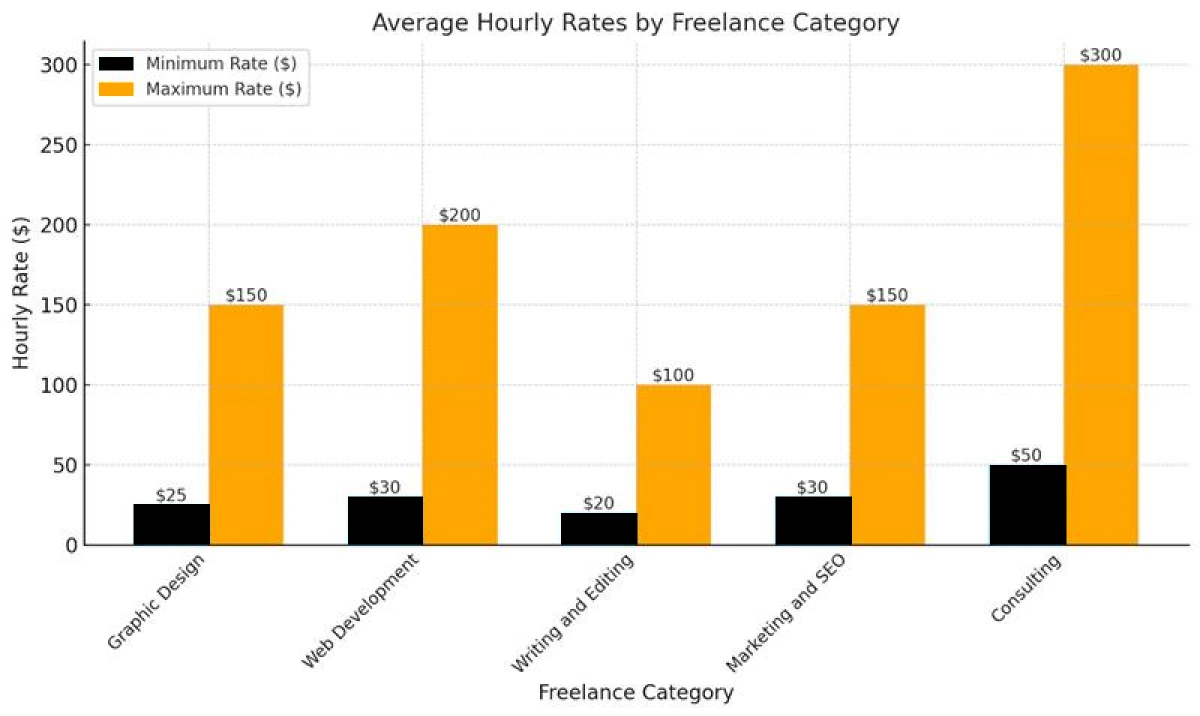
| Freelance Category | Average Hourly Rate (USD) | Description |
| Artificial Intelligence (AI) Specialist | $30 – $60 | AI professionals develop intelligent systems and algorithms with expertise in machine learning and data analysis. |
| Blockchain Developer | $30 – $59 | Specialists in blockchain technology create decentralized applications and solutions, particularly in the finance and supply chain sectors. |
| Cybersecurity Expert | $40 – $90 | Cybersecurity developers ensure clients’ systems are protected against cyber threats, maintaining data integrity and security. |
| Data Scientist | $49.76 | Data scientists analyze complex data sets to derive actionable insights, aiding strategic decision-making. |
| Software Developer | $59.71 | Software developers design and build applications across various platforms, meeting diverse client needs. |
| Digital Marketing Consultant | $15 – $45 | Consultants develop and implement online marketing strategies to enhance brand visibility and engagement. |
| Public Relations Manager | $50 – $100 | PR managers craft and manage public images for clients, handling media relations and communication strategies. |
| Business Consultant | $28 – $98 | Business consultants provide expert advice to improve organizational efficiency and profitability. |
| Project Manager | $45.85 | Project managers oversee project planning and execution, ensuring timely and budget-compliant delivery. |
| Technical Writer | $38.44 | Technical writers create clear and concise documentation, manuals, and guides for complex products and services. |
These categories not only boost your earnings significantly but also provide opportunities for professional growth and development in the dynamic freelance market, thus making them great avenues for anyone looking to start freelancing.
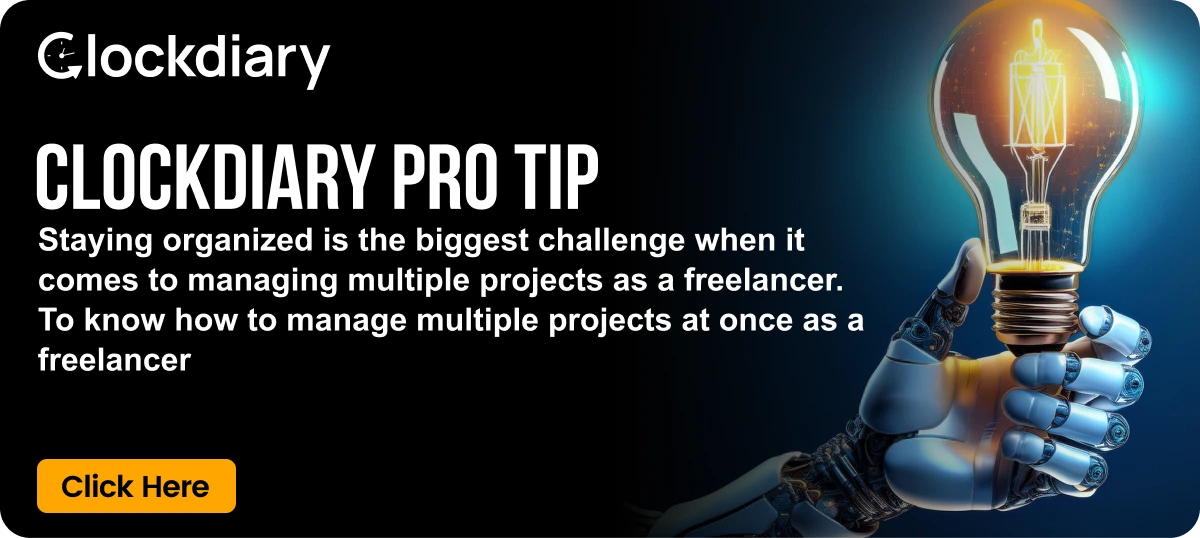
Venturing into a freelancing career in 2025 offers numerous opportunities, especially with platforms customized for beginners. Here are some top freelancing platforms to consider:
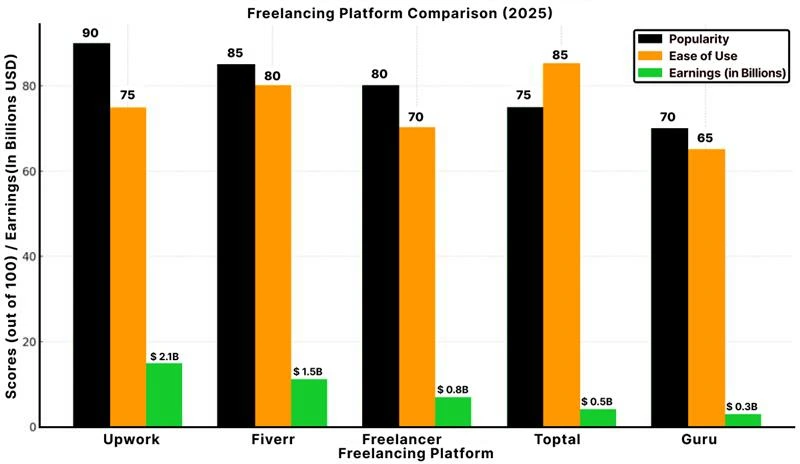
Upwork is ideal for beginners because it hosts a wide array of freelance categories, from writing to software development. Its intuitive interface allows freelancers to create detailed profiles, showcasing skills, and portfolio. Upwork’s job proposal system ensures you can bid on projects aligning with your expertise. What sets Upwork apart is its talent badges and rising talent program, which help beginners gain visibility quickly, thereby increasing their chances of landing jobs.
Fiverr is another beginner-friendly platform designed for creative professionals. Unlike traditional job bidding, you list “gigs” showcasing your services, starting at $5 and scaling upwards. Fiverr’s gig-based system enables freelancers to focus on delivering defined services without negotiating terms repeatedly. Its unique selling point is the creative freedom to offer niche services, from logo design to voiceovers, making it perfect for those with specific skills.
Freelancer.com offers a diverse range of job postings and supports beginners with its contest feature. You can showcase your work in competitions, thus gaining experience and visibility without bidding on jobs. The affordability and flexibility it brings to the table make it a strong contender for beginners.
While Toptal is known for elite freelancers, it’s worth considering if you have a niche skill and want to stand out. Toptal rigorously screens its freelancers, ensuring only the top 3% are accepted. Beginners who pass the vetting process benefit from high-paying clients and minimal competition, making it a lucrative choice for skilled professionals.
Guru connects freelancers with clients seeking specialized skills. The platform offers a workroom feature for project management and secure payment options. Beginners can create comprehensive profiles and find projects that align with their expertise.
When selecting a platform, consider factors such as the types of projects available, fees, and the level of competition. Creating a compelling profile and actively engaging with potential clients are crucial steps toward building a successful freelancing career.
Starting a freelance career can be exciting and empowering, offering flexibility and control over your work life. However, success requires strategic planning and consistent effort. Follow these 11 steps to establish a thriving freelance business.
Before diving in, define what freelancing means for you. Ask yourself:
Setting specific, measurable goals will guide your decisions and keep you focused. For instance, if your long-term goal is to become a full-time freelancer, identify milestones such as building a steady client base or reaching a certain income level.
To stand out, specialize in a niche where you excel. Generalists often struggle to attract high-paying clients, so focus on specific skills or industries. For example:
List your strengths and the services you are confident in offering. Clear specialization helps build a compelling pitch and attracts the right clients.

Understanding your target audience is one of the most important steps to start freelancing. Research industries or businesses that require your expertise. Create a client persona by answering the following:
Tailor your approach to meet the specific needs of your target audience.
Setting the right price is a balancing act. Research industry standards and consider your experience level. Common pricing strategies include:
Avoid underselling yourself. Charge rates that reflect your expertise while staying competitive.
Your online presence is your digital storefront. Essentials include:
Ensure your profiles and websites are professional and easy to navigate.

Marketing is critical to attracting clients. Effective strategies include:
Be consistent with your marketing efforts to build visibility and credibility.
Networking can open doors to opportunities. Attend industry events, webinars, or online forums to connect with potential clients and peers. Here are some tips for networking:
Building relationships often leads to repeat business and referrals.
Getting your first clients can be challenging but rewarding. Start with:
Once you secure clients, deliver high-quality results to build trust and establish your reputation. This will prove to be a boon when you start freelancing.

Repeat business is more profitable than constantly finding new clients. Build strong relationships by:
Happy clients often become long-term collaborators and advocates for your services.
Freelancing demands staying ahead in your field. Invest in skill development through:
Consistently improving your expertise enhances your value and competitiveness.
As you gain experience, think long-term. Scale your freelance business by:
With a growth mindset, freelancing can evolve into a fulfilling and sustainable career.
In the end, we can say that a mix of planning, skill, and persistence is required to start freelancing in 2025. By following these 11 steps, you’ll not only navigate the challenges of freelancing but also position yourself for long-term success.
Freelancing offers freedom and flexibility, but it also comes with challenges that can derail your success if not managed carefully. Avoiding these common mistakes can help you build a sustainable freelance career.
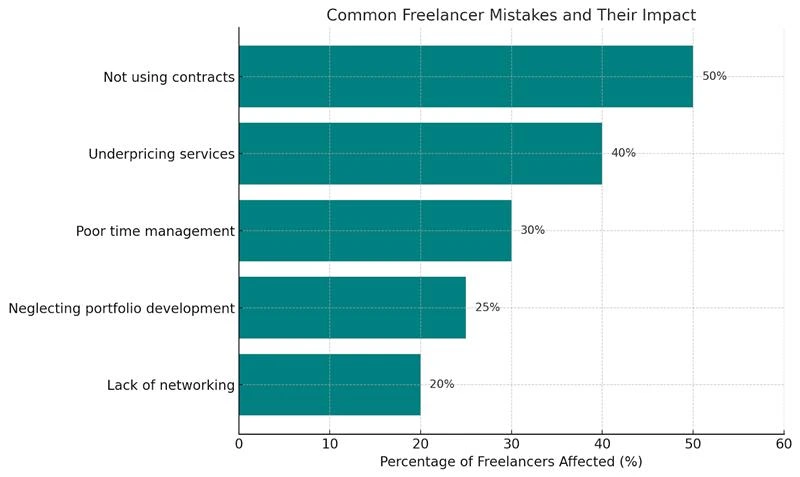
It’s tempting to agree to tight deadlines to impress clients or secure a project. However, failing to account for unexpected delays—like revisions, technical issues, or unforeseen emergencies—can lead to stress, subpar work, and strained client relationships.
Always evaluate the project’s scope and your current workload before committing. Add buffer time for contingencies and communicate realistic timelines upfront to ensure mutual understanding.

Freelancers often feel the need to be available around the clock to please clients, but this can lead to burnout and blurred boundaries. While occasional flexibility is fine, consistently responding to late-night emails or calls sets unhealthy expectations.
Set clear working hours and communicate them to your clients. Use tools like email autoresponders to politely inform clients of your availability. Respecting your time encourages clients to do the same.
One of the biggest pitfalls freelancers face is beginning a project without formalizing the terms. This can lead to misunderstandings about scope, timelines, payments, or revisions. The Upwork’s Research Institute’s 2023 Freelance Forward survey emphasizes that clear contracts are crucial for protecting both freelancers and clients.
Always use a contract that outlines project details, payment terms, and deadlines. Contracts protect both you and the client, ensuring accountability and reducing disputes. If a client hesitates about formal agreements, consider it a red flag.

Many freelancers undervalue their services, especially in the early stages, fearing that higher rates will drive clients away. This approach not only impacts your earnings but can also lower your perceived value in the market.
Research industry standards for your niche and set rates that reflect your skills and experience. According to Zip Recruiter’s statistics, the average hourly rate of freelancers in the US is $48, with most rates ranging from $24.28 to $61.78.
Be confident in communicating your value to clients. If a client insists on low rates, it’s often better to walk away and focus on opportunities that align with your worth.
Word-of-mouth referrals are valuable, but relying exclusively on them can limit your growth. Without active marketing, you risk inconsistent workloads and missed opportunities. With 76.4 million freelancers in the US as of 2024, competition is fierce, making proactive marketing strategies absolutely essential for standing out.
Develop a comprehensive marketing strategy to promote your services. This can include maintaining an updated LinkedIn profile, sharing portfolio samples on social media, and engaging in online communities related to your niche. Platforms like Upwork, Fiverr, or Behance can also help you reach a broader audience. A strong online presence ensures you remain visible to potential clients even during slow referral periods.
Avoiding these common mistakes can significantly enhance your freelancing journey. By managing your time wisely, setting boundaries, formalizing agreements, pricing your services appropriately, and actively promoting your work, you can create a successful freelance career that’s both rewarding and sustainable. Remember, the key is to start freelancing as a business, with a focus on professionalism and long-term growth.
Yes, beginners with no experience can start freelancing, but success requires determination, learning, and strategic planning.
Start by identifying a skill you are passionate about and build expertise through online courses, tutorials, or internships.
Create a basic portfolio with sample projects, even if they aren’t for paying clients.
Use freelancing platforms like Fiverr or Upwork to find entry-level gigs, offering competitive rates initially to gain experience.
Networking, consistent learning, and excellent client communication can help you build credibility and scale over time. With persistence, even those starting from scratch can establish a thriving freelancing career.
Choosing a specific niche for freelancing can position you as an expert, helping you attract clients and command higher rates. Here’s a step-by-step guide to start freelancing in some of the most popular niches:


Freelancing in a specific niche not only allows you to focus on what you enjoy but also helps you build authority and attract higher-paying clients. Whether it’s web development, UI/UX design, content marketing, or social media management, mastering the basics, building a strong portfolio, and effectively marketing your skills are crucial steps to success.
Time tracking proves to be a boon for freelancers striving to boost productivity, meet deadlines, and ensure accurate billing. Among the many tools available, Clockdiary stands out as an intuitive, feature-rich platform tailored to freelancers. Here’s a comprehensive look at how Clockdiary can help you manage your time effectively and maximize your freelance success.
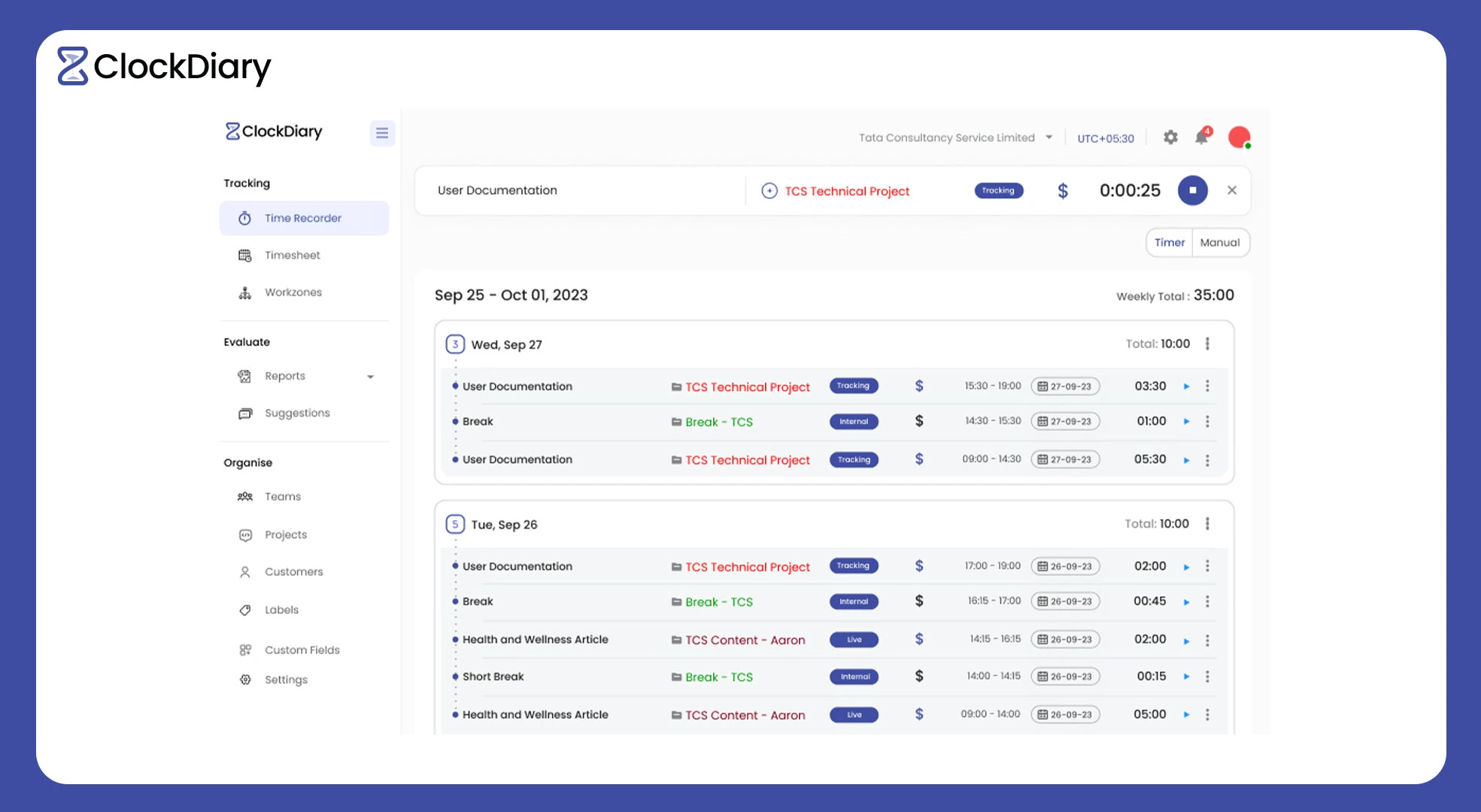
Clockdiary’s core feature is its user-friendly time tracker. Whether you are working on a web development project or writing content, you can easily start and stop the timer with a single click. For freelancers managing multiple tasks, this feature accurately records every minute spent on billable work. You can also manually add time entries for tasks you may have forgotten to track in real-time.
The timesheet feature is a lifesaver for freelancers managing multiple projects. It allows you to visualize your tracked time over days, weeks, or months, providing a clear picture of your productivity. The timesheets are also customizable, allowing you to categorize entries by project, task, or client, thus ensuring seamless organization.
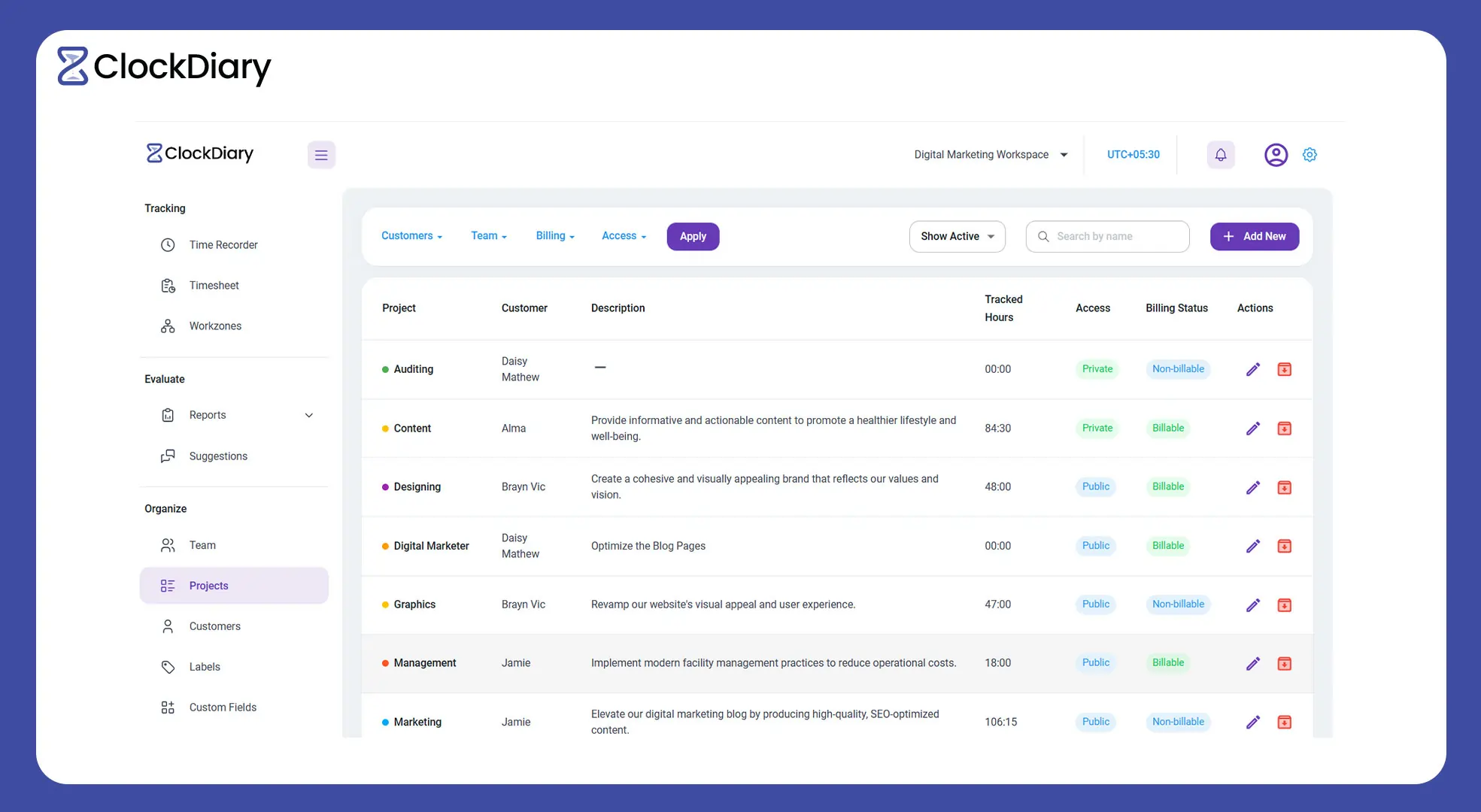
Clockdiary’s project and task management tools help you structure your workflow. Assign specific tasks to team members, create, organize, and oversee all project activities in one place. This is especially helpful for freelancers handling long-term projects, as it keeps you on track while ensuring you do not exceed the allocated hours.
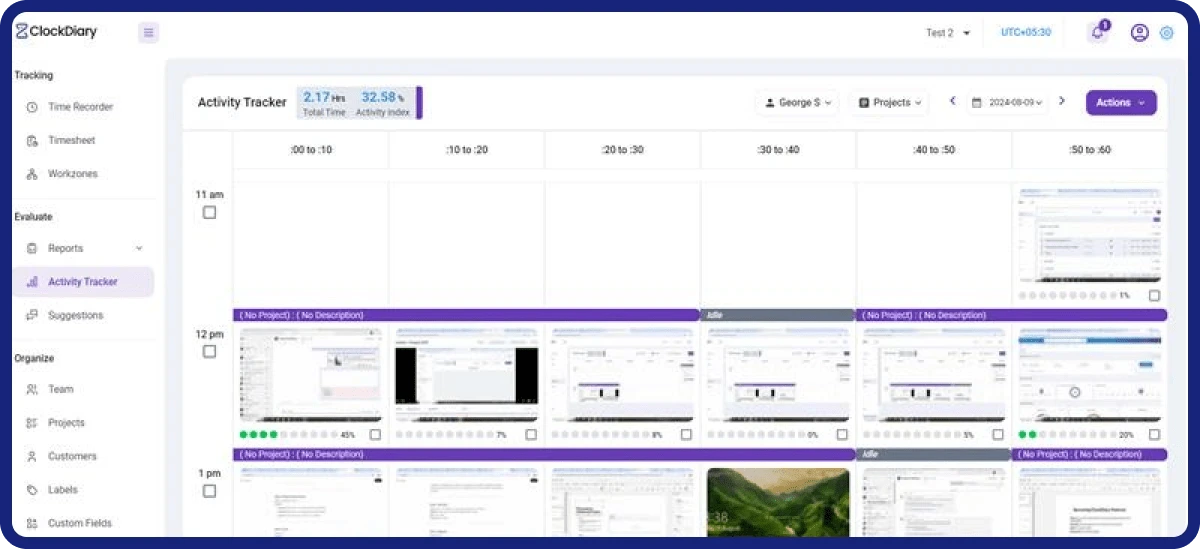
Clockdiary’s “activity tracker” captures screenshots at regular intervals to monitor your engagement with different applications and websites. Thus, it provides a comprehensive view of how you spend your time. This data helps identify distractions and enhance focus.
Clockdiary provides insights into your work patterns, helping you identify productivity trends and areas for improvement. By analyzing your activity, you can make informed decisions to improve your workflow.
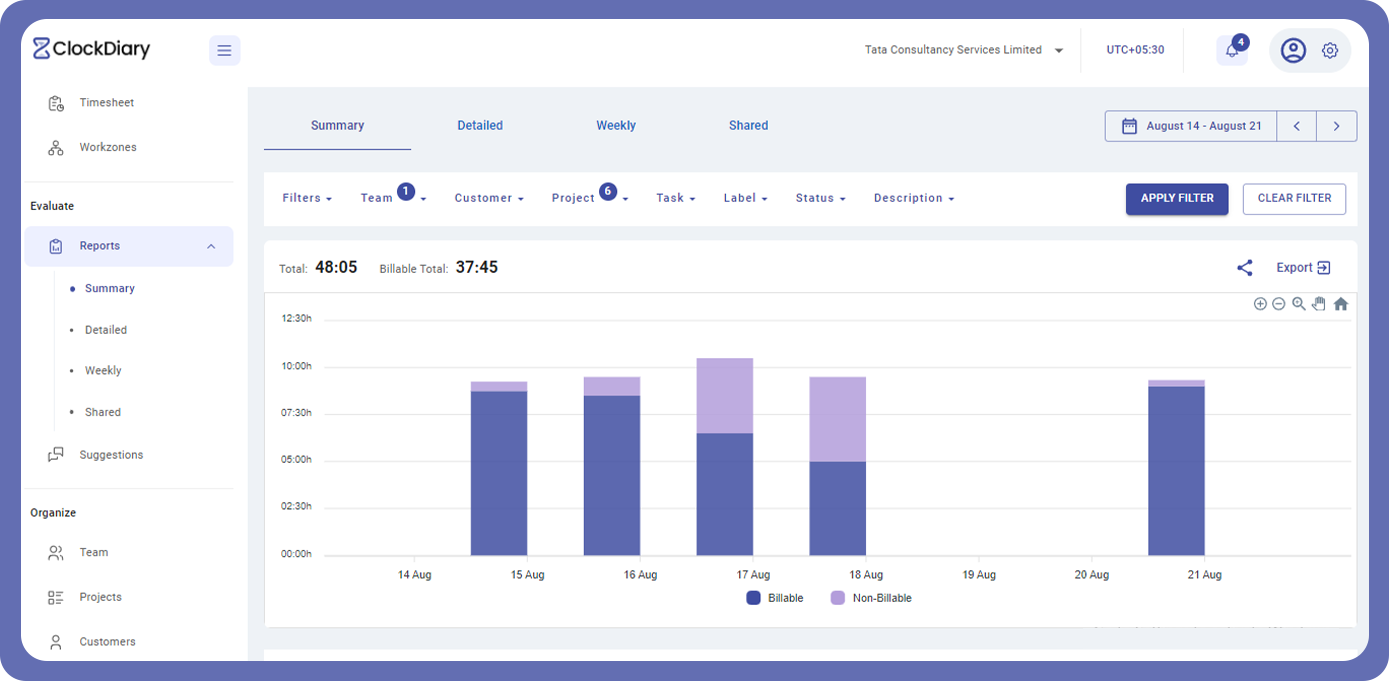
Clockdiary’s robust reporting tools offer detailed insights into how your time is spent. With just a few clicks, you can generate reports that break down hours by project, task, or client. These reports are not only useful for your own analysis but can also be shared with clients to demonstrate your efforts transparently.
Clockdiary’s AI Rule Engine helps track employee productivity effectively and efficiently. It packs top-notch reporting and monitoring tools such as an “activity tracker,” which helps assess productivity levels. These features enable freelancers to evaluate their performance and make necessary adjustments.
One of Clockdiary’s standout features is its ability to simplify invoicing. By linking your tracked time to specific clients and projects, you can create accurate invoices in minutes. This eliminates the guesswork and ensures you get paid for every billable hour, improving your cash flow and maintaining client trust.
Clockdiary integrates seamlessly with popular productivity tools. This allows you to track time directly from your favorite apps without disrupting your workflow. For freelancers who rely on multiple tools to manage their projects, this integration is a huge advantage.
Clockdiary’s comprehensive suite of features caters perfectly to freelancers’ unique needs. It simplifies time tracking, ensures accurate billing, and provides insights to improve efficiency—all essential elements to start freelancing. Whether you are managing one project or balancing multiple clients, Clockdiary keeps you organized, productive, and confident in your time management skills.
Mastering time tracking as a freelancer is critical for success, and Clockdiary makes it easy. Its user-friendly interface, powerful reporting tools, and flexible integrations empower freelancers to stay on top of their workload, impress clients with detailed reports, and ensure they are compensated fairly. If you are looking to take control of your time and boost your freelance productivity, Clockdiary is the tool to master. Get in touch with us and let us take care of the time tracking while you focus on delivering quality work to clients.

FAQs:
To start freelancing as a beginner, identify your skills, choose a niche, and create a professional online portfolio showcasing your expertise. Then, join freelance platforms like Upwork or Fiverr to find clients, set competitive rates, and begin building your reputation.
The best freelancing skills depend on market demand, but high-paying niches like web development, graphic design, content writing, and digital marketing are consistently in demand. It’s important to choose a skill you are passionate about and that aligns with your strengths while also considering industry trends.
Yes, freelancing on mobile is possible with various apps that allow you to manage projects, track time, communicate with clients, and even submit work. Many freelancing platforms, such as Upwork and Fiverr, also have mobile apps, enabling you to stay connected and work on the go.